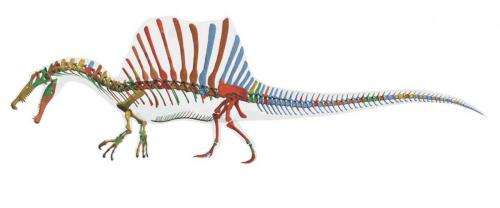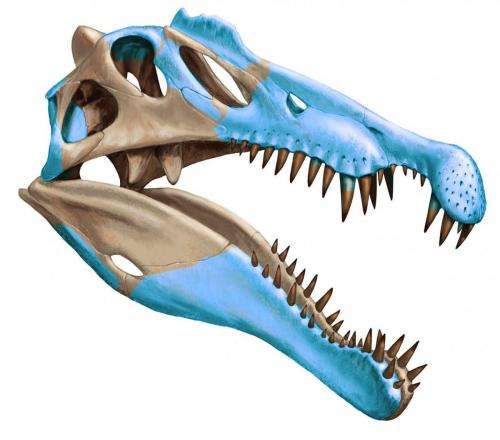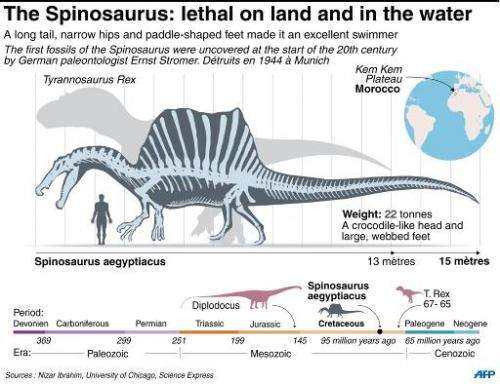Shark-munching Spinosaurus was first-known water dinosaur

There once was a dinosaur, bigger than a T. rex, that swam with the sharks—and ate them for dinner.
The first evidence that a fierce and well-known meat-munching dinosaur, Spinosaurus aegyptiacus, was adapted for both land and water was featured in the US journal Science on Thursday.
Picture a giant hybrid of a duck and a crocodile that lived 95 million years ago, sloshing through rivers and feasting on prehistoric sharks, sawfish and lungfish.
The 20-metric-ton beast boasted a crest on its back, akin to a boat's sail, held aloft with spines as tall as an average human.
Its long tail, narrow hips and paddle-shaped feet likely helped the 50-foot-long (15-meter) creature move through the water with ease, experts said.
Spinosaurus also had dense bones to help control its buoyancy in water, and a long snout with high-set nostrils that could allow easy breathing while partially submerged.
"Taken together, these features strongly suggest that Spinosaurus was the first dinosaur that spent a significant amount of time in the water," said lead author Nizar Ibrahim, a paleontologist at the University of Chicago.
Movie scenes 'wrong'
The 2001 movie Jurassic Park III features a scene in which a Spinosaurus attacks a Tyrannosaurus rex and snaps the legendary carnivore's neck.
Scientists have long known the scene was not accurate. T. rex lived in North America some 30 million years after Spinosaurus disappeared, and Spinosaurus bones have been unearthed only in Africa.
But Paul Sereno, a paleontologist and co-author of the study also from the University of Chicago, said the latest research casts even more doubt on that Hollywood portrayal.
Spinosaurus might have made nests for its young on land but the front-heavy creature would not have been particularly agile on solid ground, he said.

"I think that we have to face the fact that the 'Jurassic Park' folks have to go back to the drawing board on Spinosaurus," Sereno told reporters.
"The evidence suggests it could not balance for a long period of time on its hind limbs."
Sereno said the Spinosaurus appeared to have "bodily adaptions showing transitions from a land-based predator to a semi-aquatic predator."
Lost in WWII
Bones from the predator's skull, vertebra, pelvis and limbs were found last year along an old riverbank in the Sahara desert, in the Kem Kem beds of eastern Morocco.
The discovery was a boon to paleontologists, who have had little to study when it came to Spinosaurus even though it was first identified from bones found in Egypt in 1912 by German paleontologist Ernst Freiherr Stromer von Reichenbach.
That collection was destroyed during World War II. In 1944, British airplanes bombed the Munich museum where they were kept.
However, not all experts are convinced that the latest findings show a swimming dinosaur.
Ken Carpenter, director and curator of paleontology at the Prehistoric Museum in Price, Utah, said the waters in the region might not have been deep enough for it to truly swim.

"The rivers in the land of Spinosaurus were small and undoubtedly shallow (hip deep at most)," Carpenter told AFP in an email.
"As for the anatomical evidence, there are lots of alternative hypotheses to explain the oddities," he added.
"The high placement of the nostrils occurs in other dinosaurs. Such an occurrence was once used as evidence that Diplodocus was aquatic."
Diplodocus was a massive, long-necked plant-eating dinosaur that lived about 150 million years ago.
"That idea has since been dropped in part because evidence of large, deep bodies of water are missing from the formation Diplodocus is found in," Carpenter said.
Researchers who worked on the paper said it is still unclear exactly how the dinosaur swam, or what its motion looked like in the water.
"It's a half-duck, half-crocodile. We don't have anything alive that looks like this animal that we can use alone as a model," Sereno said.
"It makes it particularly interesting to figure out in the future what it was doing."
An exhibit featuring a life-sized model of the Spinosaurus opens to the public at the National Geographic Museum in Washington on Friday.
More information: Paper: "Semiaquatic adaptations in a giant predatory dinosaur," by N. Ibrahim et al. Science, www.sciencemag.org/lookup/doi/ … 1126/science.1258750
The life-size skeletal replica will be the centerpiece of a new exhibition at the National Geographic Museum in Washington, D.C., titled "Spinosaurus: Lost Giant of the Cretaceous." The exhibition, which runs from Sept. 12, 2014, to April 12, 2015, brings to life the story of Spinosaurus, from Stromer's original discoveries to the dedicated efforts of the international research team working to unlock its secrets. For more information on this interactive, multimedia experience developed in collaboration with UChicagoTech, the university's Center for Technology Development & Ventures, visit ngmuseum.org.
The global search to uncover the Spinosaurus skeleton and its mysteries will also be featured in a National Geographic/NOVA special, "Bigger Than T.rex," airing on PBS Nov. 5, 2014, at 9 p.m.
Journal information: Science
© 2014 AFP



















